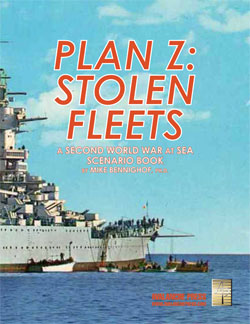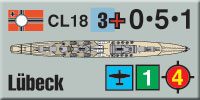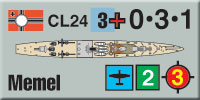| Stolen Fleets:
Publisher’s Preview
by Mike Bennighof, Ph.D.
July 2022
 The German Plan Z is probably the most famous fleet that never existed. We added it to the Second World War at Sea line up with Plan Z, the most popular book or expansion set we’ve ever made. So it’s only natural that we’d want to expand the expansion. The German Plan Z is probably the most famous fleet that never existed. We added it to the Second World War at Sea line up with Plan Z, the most popular book or expansion set we’ve ever made. So it’s only natural that we’d want to expand the expansion.
Plan Z: Stolen Fleets is pretty much what it sounds like, an expansion book for Plan Z adding warships stolen from defeated enemies (France, the Netherlands and the Soviet Union) to the German Kriegsmarine. Most of these are ships that would have been under construction when German forces overran their shipyards; some of the former French ships would have been handed over as part of a peace settlement.
It also extends the Plan Z story, which opens in August 1942 with the Germans having just completed the occupation of Norway with Swedish assistance. Soon Britain stands alone, with the Royal Navy facing a greatly enlarged Kriegsmarine in a lengthy campaign for control of the North Atlantic sea routes. The story ends on a cliffhanger in May 1943, as the Germans launch an invasion of Iceland into the teeth of British resistance.
 Stolen Fleets picks up the story in the aftermath, with the Germans now in need of reinforcements following the battles around Iceland, the Faroe Islands and the Shetland Islands. There are thirty scenarios, the same number as Plan Z, taking the story of the Long War in the North Atlantic through the end of 1943. They’re organized in the same story arc fashion. Stolen Fleets picks up the story in the aftermath, with the Germans now in need of reinforcements following the battles around Iceland, the Faroe Islands and the Shetland Islands. There are thirty scenarios, the same number as Plan Z, taking the story of the Long War in the North Atlantic through the end of 1943. They’re organized in the same story arc fashion.
In the Long War story arc, Germany makes war on the Soviet Union in early 1940, intervening in the Soviet-Finnish Winter War. Leningrad fell in the summer of 1941 and the Soviet Union collapsed one year later. The naval shipyards in Leningrad would be “privatized” even before the war’s official end, with the Nazi barons gleefully raking in the windfall. By late 1941 they had been brought back into service, resuming construction on the warships left on the slipways.
 France fell in October 1942, following an unexpected Blitzkrieg. The Germans demanded, and received, the French fleet in exchange for not demanding territorial annexations beyond the borders of 1914. But they did occupy the French Atlantic ports, and ordered the shipyards there to resume work on the ships lying incomplete, this time for the German fleet. A similar fate awaited the pair of light cruisers under construction for the Royal Netherlands Navy in Dutch shipyards. France fell in October 1942, following an unexpected Blitzkrieg. The Germans demanded, and received, the French fleet in exchange for not demanding territorial annexations beyond the borders of 1914. But they did occupy the French Atlantic ports, and ordered the shipyards there to resume work on the ships lying incomplete, this time for the German fleet. A similar fate awaited the pair of light cruisers under construction for the Royal Netherlands Navy in Dutch shipyards.
The key selling point to Second World War at Sea fans, of course, is the collection of new toys. There are sixty “long” ship pieces and twenty square ones. The little ones are mostly new carrier planes, adding some more capable aircraft to carrier wings. The big ones, of course, are ships.
 To start with, the Germans receive a handful of new German-built ships, or at least ships proposed by the Kriegsmarine but never actually built. There are six huge battleships of the H41 class, an attempt to show that Germany could build a battleship even bigger and even more poorly-designed than the original H class (which appears in Plan Z). They would have been an enlarged, 74,000-ton version of the H-class, with 420mm guns which were simply the heavy, thick barrels of the H class 406mm guns bored out to a larger caliber. And they apparently would have shared all of the H class vulnerabilities. To start with, the Germans receive a handful of new German-built ships, or at least ships proposed by the Kriegsmarine but never actually built. There are six huge battleships of the H41 class, an attempt to show that Germany could build a battleship even bigger and even more poorly-designed than the original H class (which appears in Plan Z). They would have been an enlarged, 74,000-ton version of the H-class, with 420mm guns which were simply the heavy, thick barrels of the H class 406mm guns bored out to a larger caliber. And they apparently would have shared all of the H class vulnerabilities.
 At the start of the war, German civilian passenger liners ran for home and some of them made it back to German ports. Several of these were slotted for conversion to aircraft carriers (and appear as such in Plan Z) depending on their civilian ownership: the Nazis bought ships from party-aligned owners at bloated prices. In Stolen Fleets a couple of liners owned by less-favored shipping lines are bought up as well. At the start of the war, German civilian passenger liners ran for home and some of them made it back to German ports. Several of these were slotted for conversion to aircraft carriers (and appear as such in Plan Z) depending on their civilian ownership: the Nazis bought ships from party-aligned owners at bloated prices. In Stolen Fleets a couple of liners owned by less-favored shipping lines are bought up as well.
And then there are the actual stolen fleets. There are just two formerly Dutch ships, the Eendracht-class light cruisers. The Germans actually captured these on the slipways, drafted revised designs to give them a German-made armament and did some work toward completing them as KH-1 and KH-2. That’s the version we have in Stolen Fleets (with more interesting names than KH-1 and KH-2); we’ll include the original design in Java Sea.
 While the Dutch yards building those cruisers were as good as any in the world, that wasn’t the case in the Soviet Union. The Soviet program of forced industrialization could produce factories that churned out mountains of semi-finished goods, but sophisticated items like turbines, gunnery directors and electronics were often beyond their capacity. Soviet battleship and battle cruiser designs were far larger than other nations’ naval architects required to produce the same capabilities, and many Soviet ships that were completed simply weren’t very well-made. Had the Germans captured the yards intact they likely would have cut up the incomplete big ships for their scrap value and built smaller ships of their own design on the slipways using salvaged materials (as they did at Nikolayev on the Black Sea). While the Dutch yards building those cruisers were as good as any in the world, that wasn’t the case in the Soviet Union. The Soviet program of forced industrialization could produce factories that churned out mountains of semi-finished goods, but sophisticated items like turbines, gunnery directors and electronics were often beyond their capacity. Soviet battleship and battle cruiser designs were far larger than other nations’ naval architects required to produce the same capabilities, and many Soviet ships that were completed simply weren’t very well-made. Had the Germans captured the yards intact they likely would have cut up the incomplete big ships for their scrap value and built smaller ships of their own design on the slipways using salvaged materials (as they did at Nikolayev on the Black Sea).
 But that wouldn’t allow us to present them in Stolen Fleets, and the Nazis weren’t big on the whole economic-logic thing anyway. Commissioning formerly enemy battleships under their twisted cross carried a certain prestige value. Beyond that, Nazi Germany was not the economic powerhouse Imperial Germany had been – the Germans depended on captured trucks and tanks to field their panzer divisions, and to a lesser extent on captured artillery, small arms and aircraft. They made use of captured warships as well, but nothing larger than a destroyer. But that wouldn’t allow us to present them in Stolen Fleets, and the Nazis weren’t big on the whole economic-logic thing anyway. Commissioning formerly enemy battleships under their twisted cross carried a certain prestige value. Beyond that, Nazi Germany was not the economic powerhouse Imperial Germany had been – the Germans depended on captured trucks and tanks to field their panzer divisions, and to a lesser extent on captured artillery, small arms and aircraft. They made use of captured warships as well, but nothing larger than a destroyer.
 The pride of the Stolen Fleets is the monstrous battleship Sovetsky Soyuz, officially under construction at Leningrad’s Ordzhonikidze Shipyard since July 1938 but actually laid down six months later as her slipway had not been completed. She was a gigantic ship, at 59,000 ton’s displacement, carrying nine 406mm (16-inch) guns. She wasn’t particularly fast, nor was she well-protected. But she was very, very big. She appeared in Soviet colors in Sea of Iron. The pride of the Stolen Fleets is the monstrous battleship Sovetsky Soyuz, officially under construction at Leningrad’s Ordzhonikidze Shipyard since July 1938 but actually laid down six months later as her slipway had not been completed. She was a gigantic ship, at 59,000 ton’s displacement, carrying nine 406mm (16-inch) guns. She wasn’t particularly fast, nor was she well-protected. But she was very, very big. She appeared in Soviet colors in Sea of Iron.
The Germans also get to complete more Soviet ships: a battle cruiser, three light cruisers and four destroyers. And they seize two small heavy cruisers, a destroyer leader and a destroyer from the active Red Navy; the others are either not worth bringing into service or sunk or damaged during the fighting.
 But most of the stolen ships in Stolen Fleets are of French origin. The Germans pick up the two Dunkerque class battle cruisers, and two Richelieu class battleships. There’s also one Clemenceau-class battleship (she appears in French colors in The Cruel Sea). But most of the stolen ships in Stolen Fleets are of French origin. The Germans pick up the two Dunkerque class battle cruisers, and two Richelieu class battleships. There’s also one Clemenceau-class battleship (she appears in French colors in The Cruel Sea).
There are also two French-built aircraft carriers of the Joffre class, which we last saw in the out-of-print Royal Netherlands Navy. To escort them we have four heavy cruisers (the very modern Algerie and three Suffren class, all of which appear in La Regia Marina in French colors) and six light cruisers, three pre-war ships (from La Regia Marina) and three that would have been under construction at the fall of France (the De Grasse class, seen in The Cruel Sea). And then there are destroyers, desperately needed by the Kriegsmarine. Eighteen of them, ranging from the Mogador-class super-destroyers down to just plain normal boats.
 All of those foreign-built ships represent a maintenance nightmare, which is the biggest reason the Germans made no great effort to mobilize them for their own use. That, and a lack of shipyard capacity and skilled workers to bring them to completion. In our Plan Z story we’ve assumed a much larger commitment of resources to the naval buildup. That can’t solve the former problem, and like some of the badly-designed German ships the captures are subject to breakdown and availability special rules. All of those foreign-built ships represent a maintenance nightmare, which is the biggest reason the Germans made no great effort to mobilize them for their own use. That, and a lack of shipyard capacity and skilled workers to bring them to completion. In our Plan Z story we’ve assumed a much larger commitment of resources to the naval buildup. That can’t solve the former problem, and like some of the badly-designed German ships the captures are subject to breakdown and availability special rules.
And that’s what you get with Plan Z: Stolen Fleets.
You can order Plan Z: Stolen Fleets right here.
Click here to order Second World War at Sea: Plan Z (book edition) right now.
Sign up for our newsletter right here. Your info will never be sold or transferred; we'll just use it to update you on new games and new offers.
Mike Bennighof is president of Avalanche Press and holds a doctorate in history from Emory University. A Fulbright Scholar and NASA Journalist in Space finalist, he has published a great many books, games and articles on historical subjects; people are saying that some of them are actually good.
He lives in Birmingham, Alabama with his wife, three children and his new puppy. He will never forget his Iron Dog, Leopold.
Want to keep Daily Content free of third-party ads? You can send us some love (and cash) through this link right here.
|
